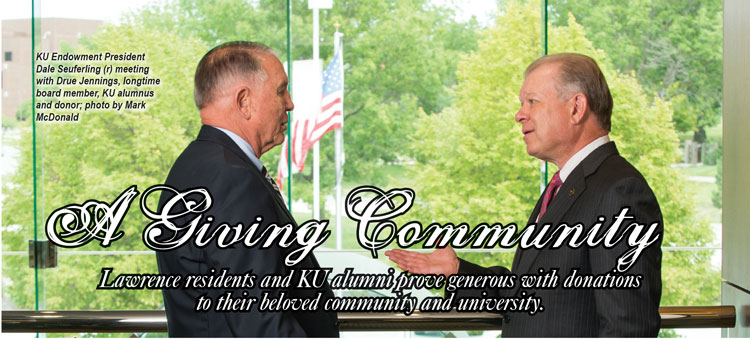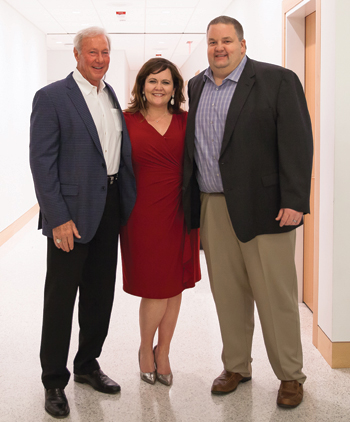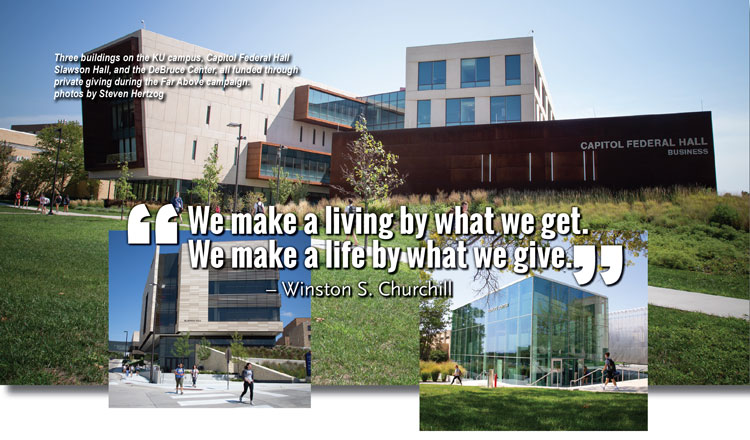Lawrence residents and KU alumni prove generous with donations to their beloved community and university.
| 2018 Q3 | story by Bob Luder

KU Endowment President Dale Seuferling (right) meeting with Drue Jennings, ongtime board member, KU alumnus and donor; photo by Mark McDonald
en.DOW.ment, n., money that is given to a college, hospital, etc. in order to provide it with an income, or the giving of this money
- Definition of “endowment” in the Cambridge English Dictionary
Ever driven by the newest building on the University of Kansas campus, attended the latest showing at the Lawrence Arts Center or witnessed the newest addition to Lawrence Memorial Hospital and wondered, “Where did the money come from to pay for all this”?
Chances are, it was donated by private citizens like you. It’s called philanthropy, and the Lawrence community has shown throughout history that it can be a giving bunch.
“I believe the people of Lawrence have always thought about the town holistically and want the whole town to thrive,” says Chip Blaser, executive director of the Douglas County Community Foundation (DCCF). “People really think about how to give back. It’s a testament to how they feel about the community.”
Monies that are given to various nonprofit organizations throughout the city and county are, for the most part, collected, managed and distributed by endowment foundations, themselves not-for-profit organizations that facilitate and invest donations from philanthropists for the purpose of supporting their affiliated bodies.
For instance, did you know that 85 percent of land on the University of Kansas (KU) Lawrence campus was provided by donations? Sixty-seven percent of all KU buildings were made possible, in part or in whole, by private support. All of that money ran, and continues to run, through the 223-strong staff at KU Endowment.
Lawrence Memorial Hospital (LMH) provides at least $20 million in charitable care each year. That is, the hospital provides care to all, regardless of ability to pay. That substantial amount is made possible by donor support through the LMH Endowment Association.
DCCF has provided funding to about 150 different nonprofit organizations throughout Douglas County—from churches to educational groups to the city itself.
Local philanthropists probably would give regardless of whether they had an endowment organization to work with, but, it’s these foundations that make charitable giving organized, efficient and effective.
“Our mission is promote philanthropy,” Blaser says. “If that’s happening through us, at LMH or KU, that’s wonderful.”
KU Endowment
The KU Endowment is historical. Established in 1891, it was America’s first foundation for a public university and was called “the fundamental prototype for more than 1,000 college and university foundations throughout the United States” by author Joseph Phelan in College & University Foundations: Serving America’s Public Higher Education, Association of Governing Boards of Universities and Colleges.
State financing covers less than 20 percent of KU’s total operating expenses. That makes private gifts vital to the survival of virtually all aspects of the University.
“(The endowment) wasn’t founded as a fund-raising organization,” says Dale Seuferling, president, KU Endowment. “But, in the 1940s and ’50s, proactive fund-raising became the norm.
“Overall, our mission is to support the university through philanthropy,” he continues.
Of the endowment’s 223 employees, 202 work in Lawrence, with 21 stationed in Kansas City and Wichita. A total of 149 are full-time, while 53 are part-time students who handle telecommuting solicitations for donations. That makes KU Endowment a major employer in Kansas.
For the fiscal year 2018, which ended June 30, KU Endowment raised $257.4 million, a significant increase from the $154.8 million raised in fiscal year 2017. Most gifts are designated by donors for specific purposes. Many are endowed gifts, which aren’t spent immediately but are invested in the endowment to be available in perpetuity.
In turn, the Endowment provided KU a record $191 million in support, an increase over last year’s total of $185.3 million, which also was a record at that time. Of that $191 million, $36.4 million was spent in student support, $40.3 million was spent on faculty, $51.7 million on construction, furnishings and equipment, and $62.6 million on program and other educational support.
“The Lawrence community benefits by being provided things like performing arts, lectures, events at the Dole Institute … ,” Seuferling says. “It all has a tremendous impact on the community at-large.”
The endowment is made up of more than 4,000 individual funds. What KU Endowment provides the University each year is a mix of current contributions plus those given in previous years that were invested in the endowment. About 5 percent of the endowment is spent every year.
There is a .9 percent income administration fee on endowed funds used to pay for the endowment’s operating costs.
“For us, the key is relationship building,” Seuferling says. “We keep donors informed about things they’ve invested in. We earn donors’ trust.
“KU is an outstanding university that provides a great product, and we’re here to support it in its mission,” he continues. “It’s an ideal collegiate setting in a quintessential college town. That makes for a fertile philanthropic atmosphere.
“It’s as positive and impactful as ever.”

Rebecca Smith with previous president Gary Sollars and current president Jason Hoover, photo from Gaskins Photography Collection
LMH Health Foundation
Lawrence Memorial Hospital recently became LMH Health (LMHEA), a change meant to recognize the ever-expanding role the organization plays in creating healthy communities in Lawrence and beyond. And, just as LMH Health has grown to serve a much larger purpose—to be a partner for lifelong health—LMH Endowment must also evolve. As LMHEA celebrates its 50th anniversary in 2019, it will do so as the LMH Health Foundation.
“LMH is on the front line of compassionate care in the Lawrence community,” says Rebecca Smith, executive director of the LMH Endowment Association. “Whether we’re talking about charity care, mental-health and substance-use crises care, or community outreach and education, the tremendous amount of mission work that LMH does is phenomenal.”
LMH is a city-owned community hospital and does not benefit from taxpayer dollars. As mentioned before, it serves anyone and everyone in need, regardless of ability to pay. The hospital’s charitable care extends beyond emergency and critical care, and includes behavioral health, substance abuse and community outreach.
“In 2017, there were 4,300 emergency room visits related to substance abuse and mental health,” Smith says.
Charitable care is a focus for the LMH Endowment Association.
“LMH offers not only exceptional care, but it’s available to all,” she says. “The endowment helps LMH meet its purpose by connecting donors to unique, patient-centered giving opportunities that provide state-of-the-art medical care and wellness initiatives for all the people we serve.”
The foundation accomplishes its goals by cultivating a strong network of philanthropists, both large and small. They range from civic leaders to former patients and family members, all wishing to help LMH remain one of the preeminent health-care facilities in the area.
“The average LMH donor is someone connected to the community, who cares deeply about the health and wellness of that community,” Smith says. “As a fund-raiser, we’re conduits. We’re helping a donor connect with something they’re passionate about.
“Hopefully, when people see the impact we’re making here, they’ll go out and bring more donors into the fold,” she continues. “There’s always a need, and donor funding creates a margin of excellence in community health.”
The LMH Health Foundation has a number of funds earmarked for specific areas of care. The Help and Healing Fund provides funds to patients for medications and treatments. Catch a Break is a survivor fund for oncology patients.
It also hosts a number of annual events to raise money and bring in more donors. Proceeds from the 2018 Penny Jones Golf Tournament, named for a late surgeon at LMH and held every September, supported the purchase of a new surgical instrumentation sterilization system. The Hearts of Gold Gala, a black-tie event, raised nearly $200,000 for the Breast Center, which will be at the LMH West facility and is targeted to open in 2020.
“The goal for the breast center is $650,000,” Smith says. “I think we’ll reach that thanks to generous major gifts and Hearts of Gold. The goal is $4 million for LMH West. Donors have provided more than $2.3 million to date.”
Rock the Block is an annual oncology fund-raiser. Last year, it raised $75,000 for vital sign monitors. It also helps pay for mammograms for women who can’t afford to pay and provides vouchers for PSA (prostate-specific antigen) tests.
“Events are a wonderful way to bring people into the fold and help the community understand how donor dollars go to work at LMH,” Smith says.
She adds that, in an average year, the foundation raises about $1.8 million and transfers about $2 million to the hospital. This year, it’s already raised $2.2 million and is on track to transfer more than $3 million.
“You come to find that, these are not endowment relationships, they’re hospital relationships,” Smith says. “With the support we get from this community, you realize LMH is a really special place.”

Douglas County Community Foundation
Executive Director Blaser is quick to point out that identifying DCCF as a fund-raising organization is inaccurate.
“We don’t really fund-raise,” he says. “We work as a way for families and donors to set up charitable plans. We advocate for philanthropy in the community. We let people know about opportunities for charitable giving.
“We’re basically an executive and educational resource for people in the community who want to be charitable,” he continues.
Blaser says DCCF holds about 225 charitable funds. A number of those are donor-advised funds, where donors have the ability to choose the nonprofit and/or charitable organizations they want to support. Others are designated funds earmarked to go to particular nonprofit organizations, such as the Lawrence Arts Center or Van Go, an arts-based social services organization in town. Still others are nondiscretionary and can be spent where there’s the greatest need.
“We can cover all aspects of the community,” Blaser says. “We’re not limited.”
DCCF also operates a community grant program that allows nonprofits to apply for grants once per year. The DCCF board designates these grants from unrestricted funds. Other committee-directed grant programs include environmental impact and education grants, or “momentum” grants, meant to break the cycle of poverty.
The impacts of such grants are felt citywide. Whether it’s disadvantaged school children receiving a new pair of shoes or a coat for the winter, the homeless getting fed a warm meal or any number of other various charitable organizations in the city, the impact DCCF makes through its facilitation of local philanthropy is immense.
“The impact we’re making on children, individuals, seniors … just the whole gamut of the community,” Blaser says. “The really neat thing for us and the benefit for people we work with is the ability to impact so many different areas of the community. The stories we hear back from the impact donors are making on the families they serve … that’s the best part of this job.”
